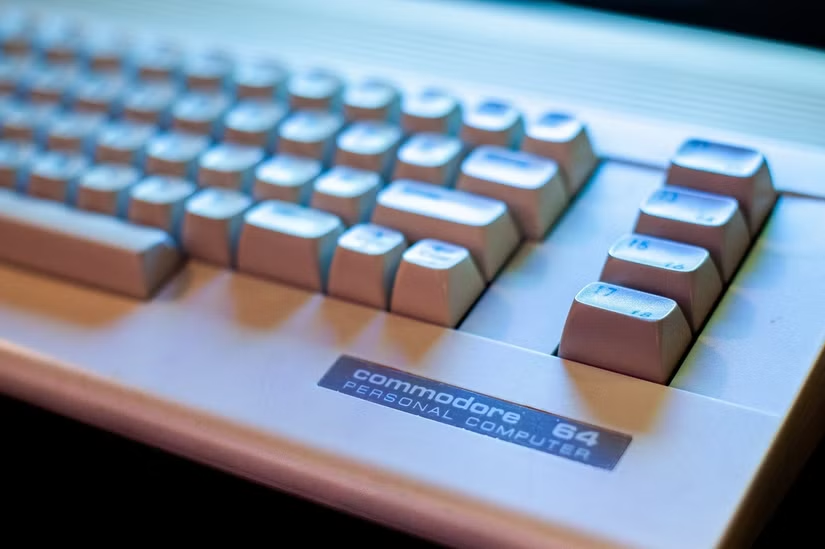The Commodore 64, also known as the C64, stands as one of the most iconic pieces of computing history. Released in 1982, this revolutionary home computer bridged the gap between professional technology and family-friendly entertainment, leaving an indelible mark on the tech world. Its success was driven by a combination of cutting-edge technology, affordability, and wide-ranging capabilities. This article delves into the origins, innovations, cultural significance, and current value of the Commodore 64.

Commodore 64
1. The Birth of the Commodore 64
The Visionary Idea
The Commodore 64 was conceived under the leadership of Jack Tramiel, the CEO of Commodore International. Tramiel aimed to create an affordable computer accessible to the general public, embodying his philosophy of “Computers for the masses, not the classes.”
Development began in 1981, with a tight schedule imposed on engineers Bob Russell, Bob Yannes, Al Charpentier, and Charles Winterble. They managed to develop the core components, including the VIC-II graphics chip and SID sound chip, by November 1981. These innovations set the stage for the C64’s groundbreaking capabilities.
Making Its Debut
The Commodore 64 was first unveiled at the Consumer Electronics Show (CES) in January 1982. Its advanced features, including superior graphics and sound, stunned competitors like Apple and IBM. With a price significantly lower than its rivals, the C64 generated immense buzz. However, it wasn’t until August 1982 that it reached store shelves in the United States, strategically timed to capitalize on the back-to-school season.
Global Expansion
The C64’s international rollout began in 1983, reaching markets in the UK, Europe, and beyond. Its adaptability and localization efforts, such as the Commodore MAX for Japan, helped establish its dominance globally. Despite occasional missteps like the unsuccessful Commodore 64 GS console, the C64 became a household name in many regions.
2. Innovations that Redefined Home Computing
Groundbreaking Hardware
The Commodore 64 offered hardware that was revolutionary for its era:
- Graphics: The VIC-II graphics chip supported 16 colors, hardware sprites, and parallax scrolling, enabling detailed and visually engaging games.
- Sound: The SID chip, designed by Bob Yannes, provided three channels of programmable audio. It delivered music and sound effects rivaling professional synthesizers.
User-Friendly Programming
The C64 came equipped with Commodore BASIC 2.0, a straightforward programming language licensed from Microsoft. While limited in complexity, it empowered users to create their own programs, fostering creativity and sparking interest in coding.
Affordability and Design
Commodore kept costs low by reusing parts, such as the VIC-20’s keyboard and casing, giving the C64 its iconic “bread bin” shape. Their in-house manufacturing of components further reduced expenses, allowing the computer to debut at $595. Over time, as production increased and competitors entered the market, prices dropped significantly, making the C64 even more accessible.
3. Cultural and Market Impact
Dominating the Gaming Scene
The C64 played a pivotal role in the gaming industry during the 1980s. Its library of over 10,000 games included iconic titles like The Last Ninja and International Karate, showcasing the machine’s impressive capabilities. The computer’s support for various storage media, including floppy disks, cartridges, and cassette tapes, catered to diverse consumer preferences.
Beyond Entertainment
While gaming was a key selling point, the C64 also served educational and productivity purposes. It was used for word processing, early spreadsheet applications, and educational programs, making it a versatile tool for families and small businesses alike.
A Global Phenomenon
Commodore’s strategic marketing ensured the C64 reached homes and schools worldwide. In Europe, it became synonymous with personal computing, maintaining dominance until the rise of IBM-compatible PCs in the late 1980s.
4. Challenges and Adaptations
Technical Constraints
Despite its innovations, the C64 had limitations. Its 64 KB of RAM and 1 MHz processor, though impressive for its time, restricted its ability to handle complex applications. However, developers employed ingenious techniques, such as sprite multiplexing and raster interrupts, to push the hardware to its limits.
Expanding Possibilities
The C64’s popularity spurred the development of add-ons, including RAM expansion units and faster disk drives. These upgrades extended its lifespan and cemented its status as a platform for innovation.
5. The Commodore 64 Today: Value and Legacy
A Collector’s Delight
The Commodore 64 remains a prized possession among retro computing enthusiasts. Depending on factors such as condition, packaging, and included accessories, original units can sell for $50 to $300. Rare models or prototypes can fetch much higher prices, especially if accompanied by original peripherals or games.
Modern Adaptations
Modern iterations like TheC64 Mini and Raspberry Pi-based replicas allow fans to relive the C64 experience with added conveniences like HDMI output and preloaded games. These adaptations preserve the essence of the original while catering to contemporary needs.
Nostalgia and Community
The Commodore 64’s legacy endures through a dedicated community of enthusiasts. Online forums, conventions, and new software releases ensure its continued relevance in the world of retro computing.
Conclusion
The Commodore 64 was more than just a computer; it was a cultural milestone that democratized technology and introduced millions to computing. Decades later, it remains a symbol of innovation and creativity, with a loyal fan base ensuring its story continues to inspire new generations. Whether experienced through vintage hardware, emulators, or modern replicas, the Commodore 64’s impact on the computing world is undeniable.






